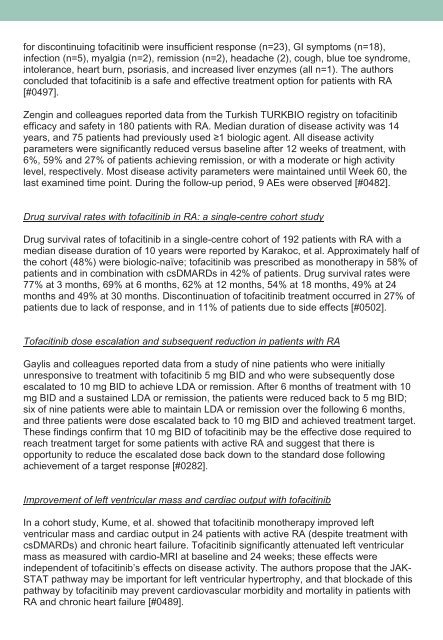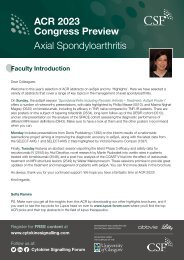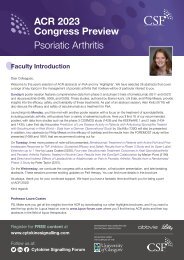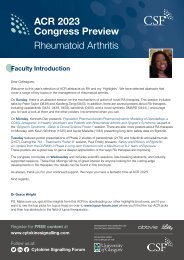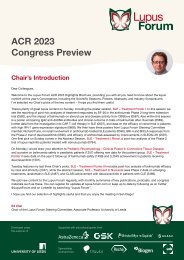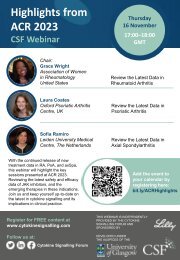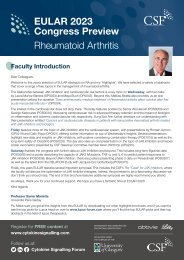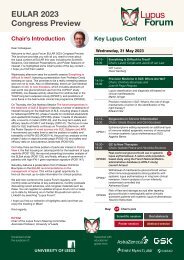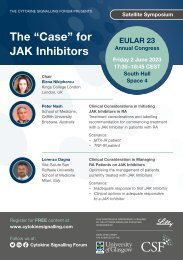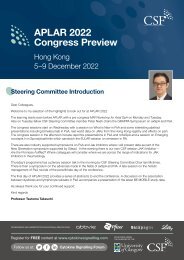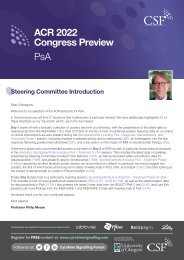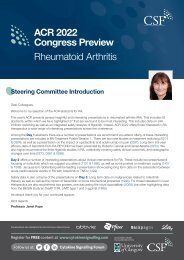EULAR 2018 Review
You also want an ePaper? Increase the reach of your titles
YUMPU automatically turns print PDFs into web optimized ePapers that Google loves.
for discontinuing tofacitinib were insufficient response (n=23), GI symptoms (n=18),<br />
infection (n=5), myalgia (n=2), remission (n=2), headache (2), cough, blue toe syndrome,<br />
intolerance, heart burn, psoriasis, and increased liver enzymes (all n=1). The authors<br />
concluded that tofacitinib is a safe and effective treatment option for patients with RA<br />
[#0497].<br />
Zengin and colleagues reported data from the Turkish TURKBIO registry on tofacitinib<br />
efficacy and safety in 180 patients with RA. Median duration of disease activity was 14<br />
years, and 75 patients had previously used ≥1 biologic agent. All disease activity<br />
parameters were significantly reduced versus baseline after 12 weeks of treatment, with<br />
6%, 59% and 27% of patients achieving remission, or with a moderate or high activity<br />
level, respectively. Most disease activity parameters were maintained until Week 60, the<br />
last examined time point. During the follow-up period, 9 AEs were observed [#0482].<br />
Drug survival rates with tofacitinib in RA: a single-centre cohort study<br />
Drug survival rates of tofacitinib in a single-centre cohort of 192 patients with RA with a<br />
median disease duration of 10 years were reported by Karakoc, et al. Approximately half of<br />
the cohort (48%) were biologic-naïve; tofacitinib was prescribed as monotherapy in 58% of<br />
patients and in combination with csDMARDs in 42% of patients. Drug survival rates were<br />
77% at 3 months, 69% at 6 months, 62% at 12 months, 54% at 18 months, 49% at 24<br />
months and 49% at 30 months. Discontinuation of tofacitinib treatment occurred in 27% of<br />
patients due to lack of response, and in 11% of patients due to side effects [#0502].<br />
Tofacitinib dose escalation and subsequent reduction in patients with RA<br />
Gaylis and colleagues reported data from a study of nine patients who were initially<br />
unresponsive to treatment with tofacitinib 5 mg BID and who were subsequently dose<br />
escalated to 10 mg BID to achieve LDA or remission. After 6 months of treatment with 10<br />
mg BID and a sustained LDA or remission, the patients were reduced back to 5 mg BID;<br />
six of nine patients were able to maintain LDA or remission over the following 6 months,<br />
and three patients were dose escalated back to 10 mg BID and achieved treatment target.<br />
These findings confirm that 10 mg BID of tofacitinib may be the effective dose required to<br />
reach treatment target for some patients with active RA and suggest that there is<br />
opportunity to reduce the escalated dose back down to the standard dose following<br />
achievement of a target response [#0282].<br />
Improvement of left ventricular mass and cardiac output with tofacitinib<br />
In a cohort study, Kume, et al. showed that tofacitinib monotherapy improved left<br />
ventricular mass and cardiac output in 24 patients with active RA (despite treatment with<br />
csDMARDs) and chronic heart failure. Tofacitinib significantly attenuated left ventricular<br />
mass as measured with cardio-MRI at baseline and 24 weeks; these effects were<br />
independent of tofacitinib’s effects on disease activity. The authors propose that the JAK-<br />
STAT pathway may be important for left ventricular hypertrophy, and that blockade of this<br />
pathway by tofacitinib may prevent cardiovascular morbidity and mortality in patients with<br />
RA and chronic heart failure [#0489].


